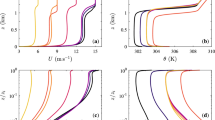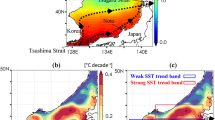Abstract
A three-dimensional numerical model is used to simulate sea level and velocity variations in the South China Sea for 1992–1995. The model is driven by daily wind and daily sea surface temperature fields derived from the NCEP/NCAR 40-year reanalysis project. The four-year model outputs are analyzed using time-domain Empirical Orthogonal Functions (EOF). Spatial and temporal variations of the first two modes from the simulation compare favorably with those derived from satellite altimetry. Mode 1, which is associated with a southern gyre, shows symmetric seasonal reversal. Mode 2, which contributes to a northern gyre, is responsible for the asymmetric seasonal and interannual variations. In winter, the southern and northern cyclonic gyres combine into a strong basin-wide cyclonic gyre. In summer, a cyclonic northern gyre and an anticyclonic southern gyre form a dipole with a jet leaving the coast of Vietnam. Interannual variations are particularly noticeable during El Niño. The winter gyre is generally weakened and confined to the southern basin, and the summer dipole structure does not form. Vertical motions weaken accordingly with the basin-wide circulation. Variations of the wind stress curl in the first two EOF modes coincide with those of the model-derived sea level and horizontal velocities. The mode 1 wind stress curl, significant in the southern basin, coincides with the reversal of the southern gyre. The mode 2 curl, large in the central basin, is responsible for the asymmetry in the winter and summer gyres. Lack of the mode 2 contribution during El Niño events weakens the circulation. The agreement indicates that changes in the wind stress curl contribute to the seasonal and interannual variations in the South China Sea.
Similar content being viewed by others
References
Chao, S.-Y., P.-T. Shaw and S. Wu (1996a): Deep water ventilation in the South China Sea.Deep-Sea Res. I,43, 445–466.
Chao, S.-Y., P.-T. Shaw and S. Wu (1996b): El Niño modulation of the South China Sea circulation.Progress in Oceanography,38, 51–93.
Csanady, G. T. (1982):Circulation in the Coastal Ocean. Reidel, Dordrecht, Holland, 279 pp.
Goddard, L. and N. E. Graham (1997): El Niño in the 1990s.J. Geophys. Res.,102, 10423–10436.
Kalnay, E., M. Kanamitsu, R. Kistler, W. Collins, D. Deaven, L. Gandin, M. Iredell, S. Saha, G. White, J. Woollen, Y. Zhu, M. Chelliah, W. Ebisuzaki, W. Higgins, J. Janowiak, K. C. Mo, C. Ropelewski, J. Wang, A. Leetmaa, R. Reynolds, Roy Jenne and D. Joseph (1996): The NCEP/NCAR 40-year reanalysis project.Bulletin of the American Meteorological Society,77, 437–471.
Levitus, S. (1982): Climatological atlas of the world ocean. NOAA Professional paper No. 13, U.S. Government Printing Office, Washington, D.C., 173 pp.
Levitus, S. (1984): Annual cycle of temperature and heat storage in the world ocean.J. Phys. Oceanogr.,14, 727–746.
Nitani H. (1972): Beginning of the Kuroshio. p. 129–163. InKuroshio, ed. by H. Stommel and K. Yoshida, University of Washington Press, Seattle.
Pohlmann, T. (1987): A three-dimensional circulation model of the South China Sea. p. 245–268. InThree-Dimensional Models of Marine and Estuarine Dynamics, ed. by J. J. Nihoul and B. M. Jamart, Elsevier, New York.
Shaw, P.-T. and S.-Y. Chao (1994): Surface circulation in the South China Sea.Deep-Sea Res.,41, 1663–1683.
Shaw, P.-T., S.-Y. Chao, K.-K. Liu, S.-C. Pai and C.-T. Liu (1996): Winter upwelling off Luzon in the northeastern South China Sea.J. Geophys. Res.,101, 16435–16448.
Shaw, P.-T., S.-Y. Chao and L.-L. Fu (1997): Sea surface height variations in the South China Sea from satellite altimetry (submitted toOceanographica Acta).
Stommel, H. M. (1948): The westward intensification of wind-driven ocean currents.Transactions American Geophysical Union,29, 202–206.
Trenberth, K. E. and T. J. Hoar (1996): The 1990–1995 El Niño— Southern oscillation event: longest on record.Geophys. Res. Lett,23, 57–60.
Wyrtki, K. (1961): Physical oceanography of the southeast Asian waters. NAGA Report Vol. 2, Scientific Results of Marine Investigation of the South China Sea and the Gulf of Thailand, Scripps Institution of Oceanography. La Jolla, California, 195 pp.
Author information
Authors and Affiliations
Rights and permissions
About this article
Cite this article
Wu, CR., Shaw, PT. & Chao, SY. Seasonal and interannual variations in the velocity field of the South China Sea. J Oceanogr 54, 361–372 (1998). https://doi.org/10.1007/BF02742620
Received:
Revised:
Accepted:
Issue Date:
DOI: https://doi.org/10.1007/BF02742620




